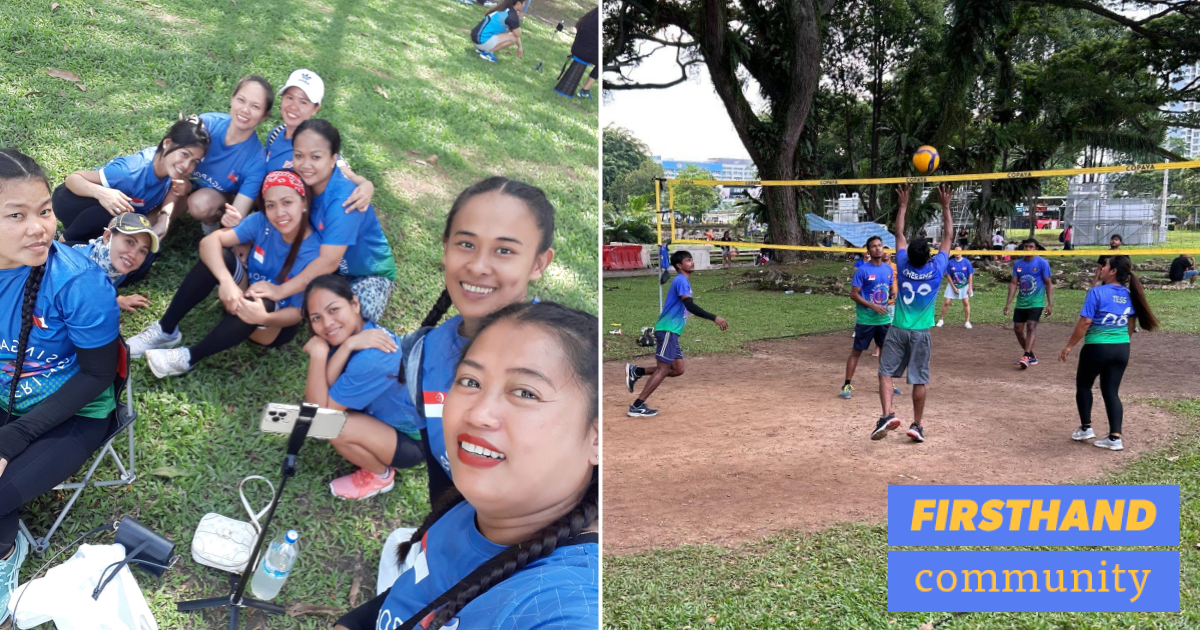Firsthand: Community is a new series by Mothership, where we explore the spirit of community in Singapore through in-depth articles and videos.
From Tampines to Tuas, we’ll investigate the untold stories of the different neighbourhoods in Singapore — firsthand.

Weekends are usually a busy time at the Singapore Sports Hub, with sports events, concerts, and members of the public using its facilities.
A field on the opposite side of Nicoll Highway from the Sports Hub, however, is just as bustling on Sundays and public holidays.
The squarish open space is the regular gathering spot for the volleyball enthusiasts of Singapore's migrant worker community — and has been for several years.
The playfield is hidden in plain sight, a mere five-minute walk from Kallang MRT station.
You might catch a glimpse of the games going on if you were on a car or bus travelling along Geylang Road toward the city, or if you were walking from Kallang MRT toward the Sports Hub.
The area is otherwise secluded, in a somewhat-forgotten corner of Singapore near the former Kallang Airport.
And while it's just a disused field on weekdays, to these migrant volleyball players, it's about all they can afford in the way of consistent, healthy, meaningful recreation.
When Mothership headed down on Sunday afternoon in September, over 10 courts had been set up and hundreds of migrant workers had gathered.

Most of the players are wearing colourful team jerseys, and the atmosphere was charged with competitive spirit; the shrill blasts of a referee's whistle, raucous cheers from teams who'd scored hard-earned points.
Each of the courts had been set up with identical volleyball nets, and on the sidelines, spectators gathered on picnic mats and folding chairs with refreshments and portable karaoke systems.
From a distance, it might have looked like a volleyball carnival or sports event, but there was no tournament going on that day.
Informal games every Sunday
These informal games happen without fail, every Sunday and public holiday, rain or shine. In fact, it was drizzling when we arrived.
Construction supervisor Md Mamun Ali, 35, a regular at the Kallang field, had earlier agreed to bring us to meet his team — Singapore Migrant Friends (SMF) — and show us around.
Mamun, meeting us at Old Kallang Airport Gateway, remarked that the turnout would have been bigger if not for the light drizzle. But it’s a sizeable crowd nonetheless, with games going on at almost every playing area.
 Mamun watching as teammates play a friendly match. Photo by Nigel Chua.
Mamun watching as teammates play a friendly match. Photo by Nigel Chua.
As we headed into the field, their consistency showed: the playing areas have become rectangular bare patches, while round patches of dirt could be seen outside the court boundaries where players serve the ball at the start of every play.
Mamun and his team were the first to set up volleyball nets on the field, sometime in 2018, and other migrant worker volleyball teams soon followed.
SMF started with casual games between a handful of friends, but through a combination of good fortune, word-of-mouth publicity, and passion for the game, the team has exploded into an inclusive community.
Games were halted during Covid-19, but as of 2022, with the easing of pandemic restrictions, volleyballers have returned to the open field at Kallang with renewed enthusiasm.
Regular tournaments have also resumed.
Just last month, a tournament organised by SMF drew 16 teams, competing to win trophies, cash prizes, and bragging rights.
The competition was paid for with the teams' entry fees, as well as contributions from Mamun, and from community organisation Citizen Adventures.
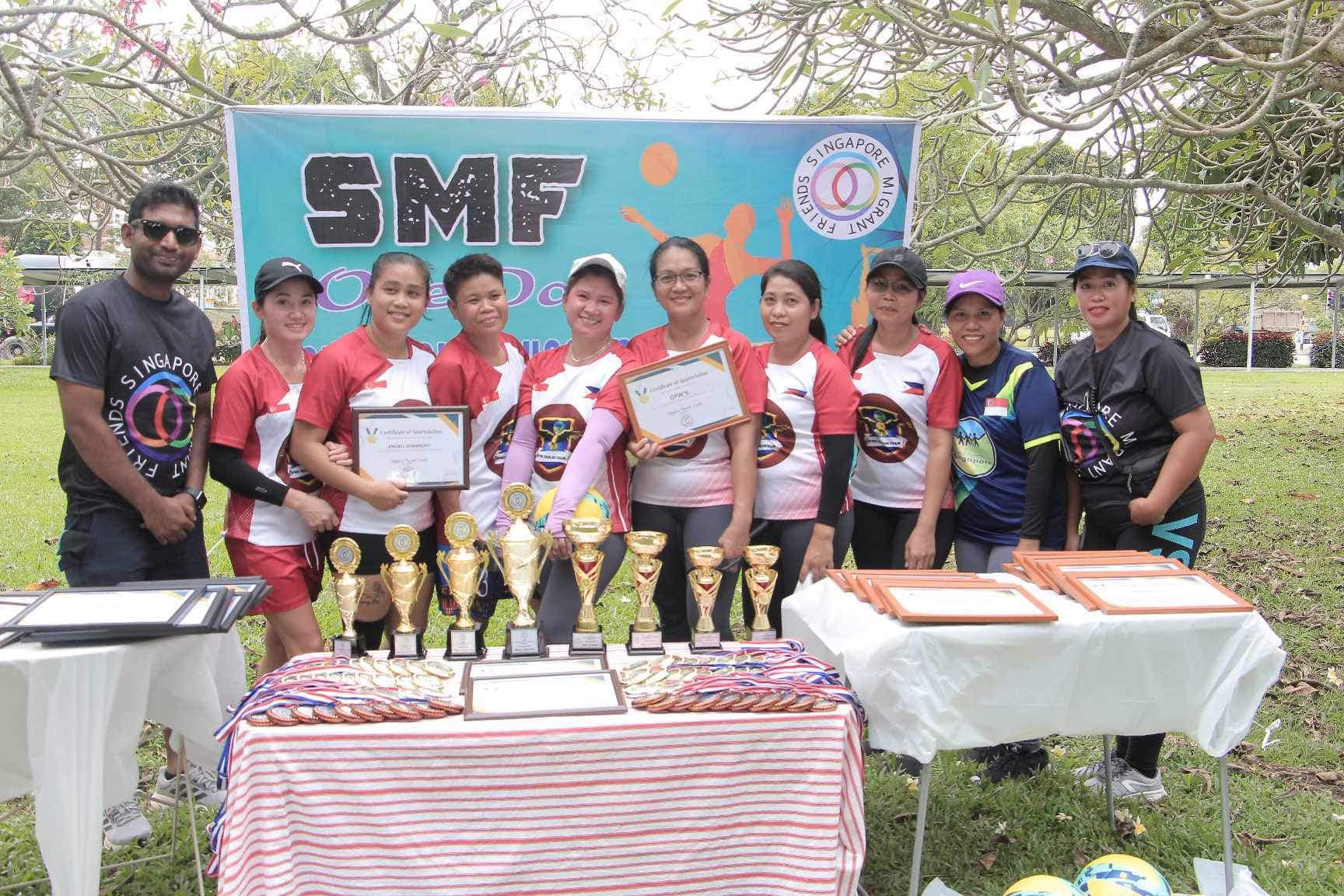 Mamun (far left) and Tess (far right) with members of a participating team at a SMF-organised volleyball tournament in August 2023. Photo via SMF on Facebook.
Mamun (far left) and Tess (far right) with members of a participating team at a SMF-organised volleyball tournament in August 2023. Photo via SMF on Facebook.
With the resumption of games, SMF is once again recruiting new members.
35-year-old Golam Mowla, one such new joiner, brings with him some years of volleyball experience.
While he stopped playing when he came to Singapore 10 years ago, he's had the chance to come back to the sport he loves thanks to SMF.
"We are migrants, right? So of course we need some recreation over the week," said Golam.
It has quickly become the highlight of his week.
"I'm very enjoying, because after finishing the Sunday, over the week I just wait for the upcoming Sunday."
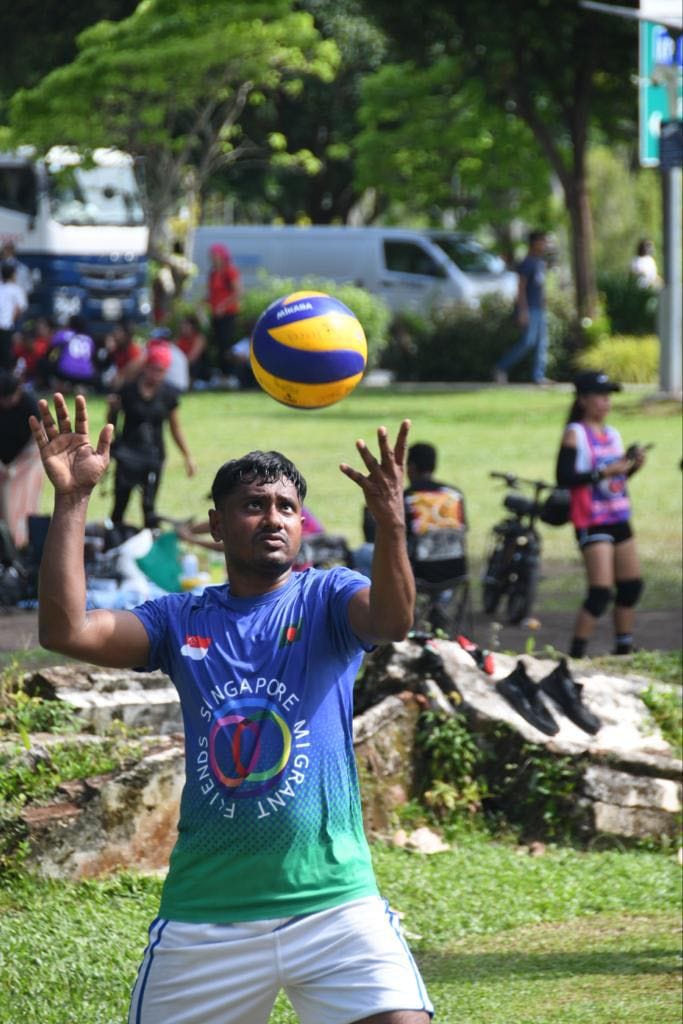 Golam serving a volleyball. Photo via SMF on Facebook.
Golam serving a volleyball. Photo via SMF on Facebook.
Why Kallang?
How did Kallang become such a volleyball hotspot? Mamun, who first came to Singapore in 2008, explains that his small group of volleyball enthusiasts played in many different locations over the years.
Each of their playing areas was, in turn, closed for redevelopment — so the group moved around a lot.
Just before moving to their current spot, the group played at the field adjacent to Kallang MRT, where the Kallang bus interchange and new residential blocks are currently being built.
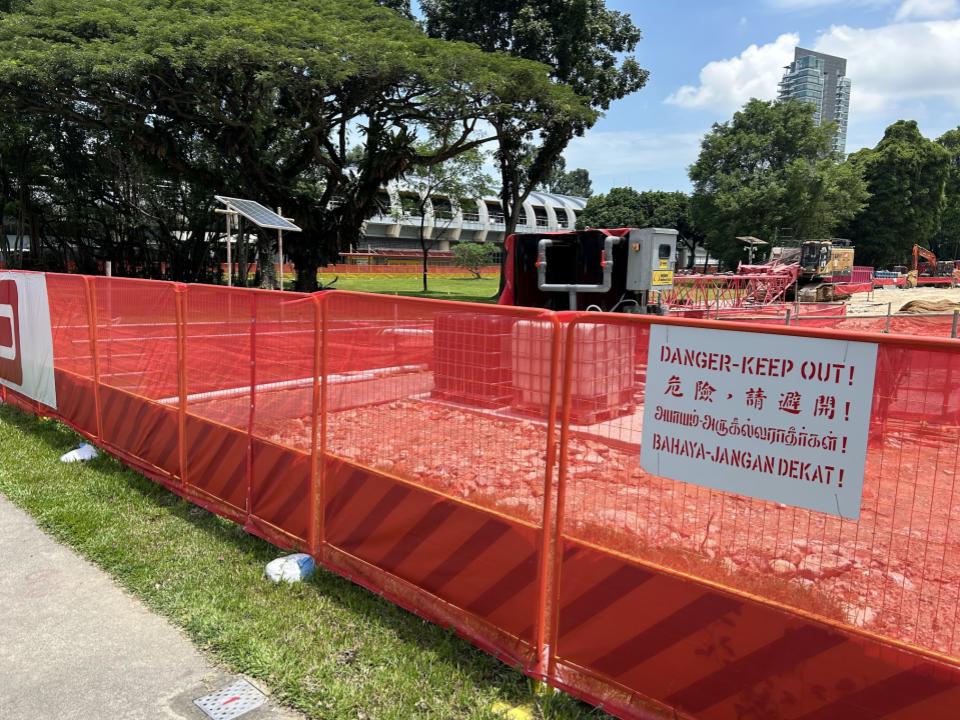 Field outside Kallang MRT. Photo by Nigel Chua.
Field outside Kallang MRT. Photo by Nigel Chua.
As the group became a consistent presence around Kallang over the years, more and more migrant workers started to join in.
It was at the field near Kallang MRT that Hasan, 39, was introduced to Mamun and his fellow volleyball players, sometime in 2016.
Hasan, an electrician and technician, remembers staying in a shophouse in Geylang at the time.
He'd gotten into the habit of taking long walks on his days off, thinking it wouldn't be good to sleep the whole day away, and stumbled upon a volleyball game.
He felt a sense of "attraction" to the ball game, but given his lack of any sports background, Hasan was hesitant to approach the group.
"So I just go there and I'm sitting to see the people playing. Slowly, slowly, I just thinking to myself, I want to play volleyball," he recalled.
Hasan got his first experience handling a volleyball from helping the team retrieve stray balls that bounced out of the court to where he was sitting.
"Then slowly slowly, I go inside the court then I start to play, and learn to play."
Hasan pointed out that while he is "not a professional player", what's most important is the group can "just enjoy" on their off days.
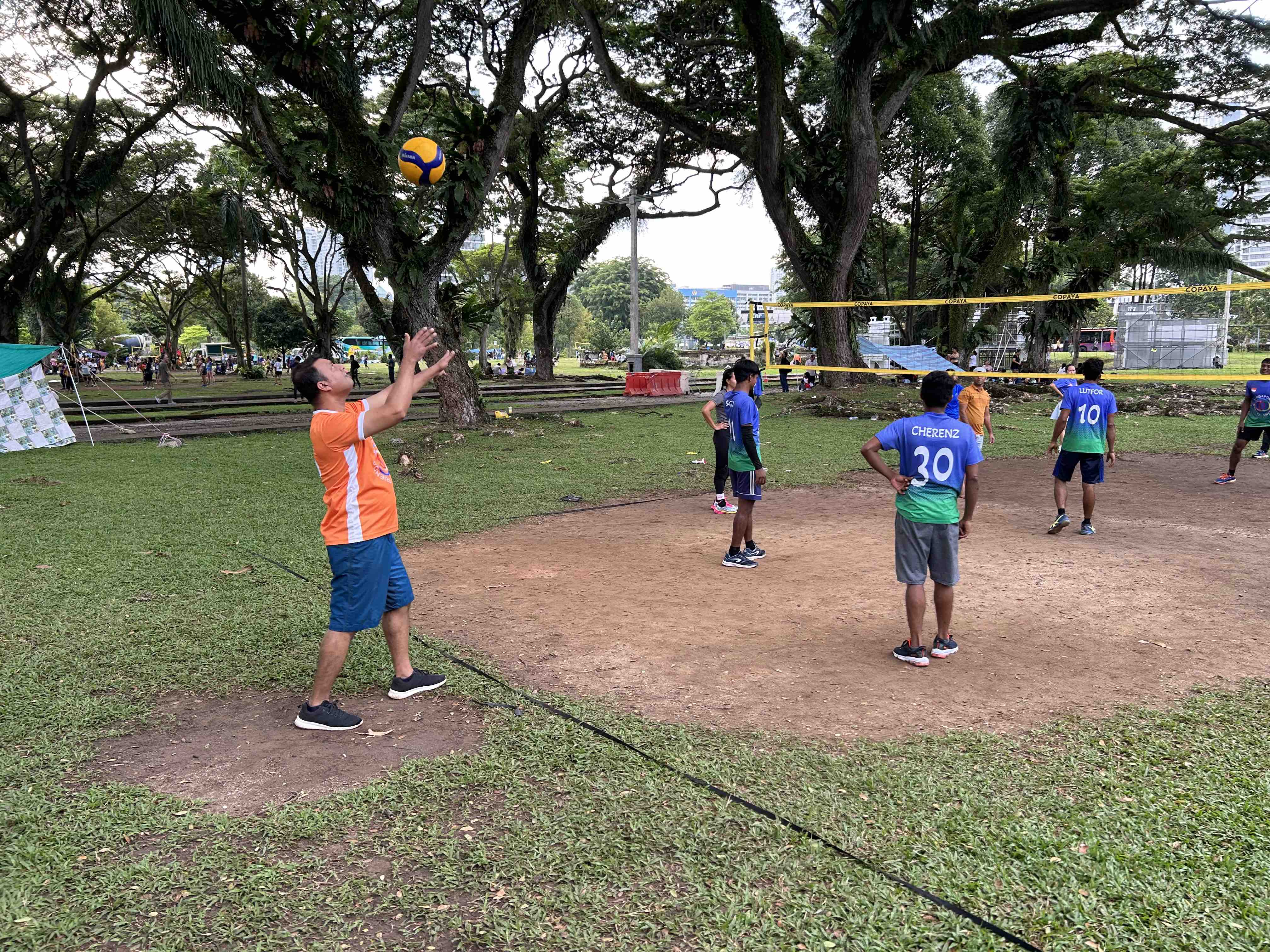 Hasan (in orange jersey) preparing to serve the ball. Photo by Nigel Chua.
Hasan (in orange jersey) preparing to serve the ball. Photo by Nigel Chua.
"Six days [a week] we're working very hard. One day only, we have time to hang out with our friends and can do what we like," said Hasan.
Why volleyball?
Like Hasan, a good number of SMF players had no prior experience in volleyball prior to joining the team.
Mamun pointed out that as South Asians, a more common sport of choice would be cricket or football instead.
He explained that volleyball ended up as the sport of choice for practical reasons — volleyball is safer for the players.
"You see, when you're throwing the cricket ball, maybe it hits some sensitive place. Maybe you need to go see the doctor. Football also same, sometimes you get hurt."
The most compelling reason of all is also a utilitarian one: Compared to cricket or football, volleyball accommodates more players in a smaller space.
The field at Kallang would hardly be able to accommodate a single football game, but when we visited, there were hundreds of players.
Steering away from trees, tree roots, and a small stretch of disused asphalt road that used to lead to the Old Kallang Airport, the players have tessellated more than 10 volleyball courts into the field — with room to spare.
But Mamun also pointed out that while the volleyball players have found an unofficial "holiday home" in Kallang, they are just a small proportion of the workers in Singapore.
“I believe many migrants don’t have a proper place to go," said Mamun, adding that he knows many workers do not even leave their dormitories on their days off.
"I wish there will be more places like this," Mamun said.
In this way, inclusiveness is an important priority for SMF.
Regardless of nationality
Of all the teams represented at the field in Kallang, SMF is one of the only ones where men and women play together, in the spirit of inclusiveness.
This made room for the team, formerly named Bangladeshi Friends (BDF), to accept new joiners in the form of domestic helpers hailing from Indonesia, the Philippines, and Myanmar.
"In here, I can feel that I have family, I can have friends," said new joiner Raquel Gustilo Salvadico, 36, who has been a domestic worker here since 2017.
While she just started playing with SMF a year ago, she's enjoying the process of improving her volleyball skills, under the guidance of more experienced teammates.
She also looks back fondly on their time together off the court, like the occasional barbecues at East Coast Park, and birthday celebrations for members of the team.
"I am happy that it's like a family here... I cannot feel homesick," she said.
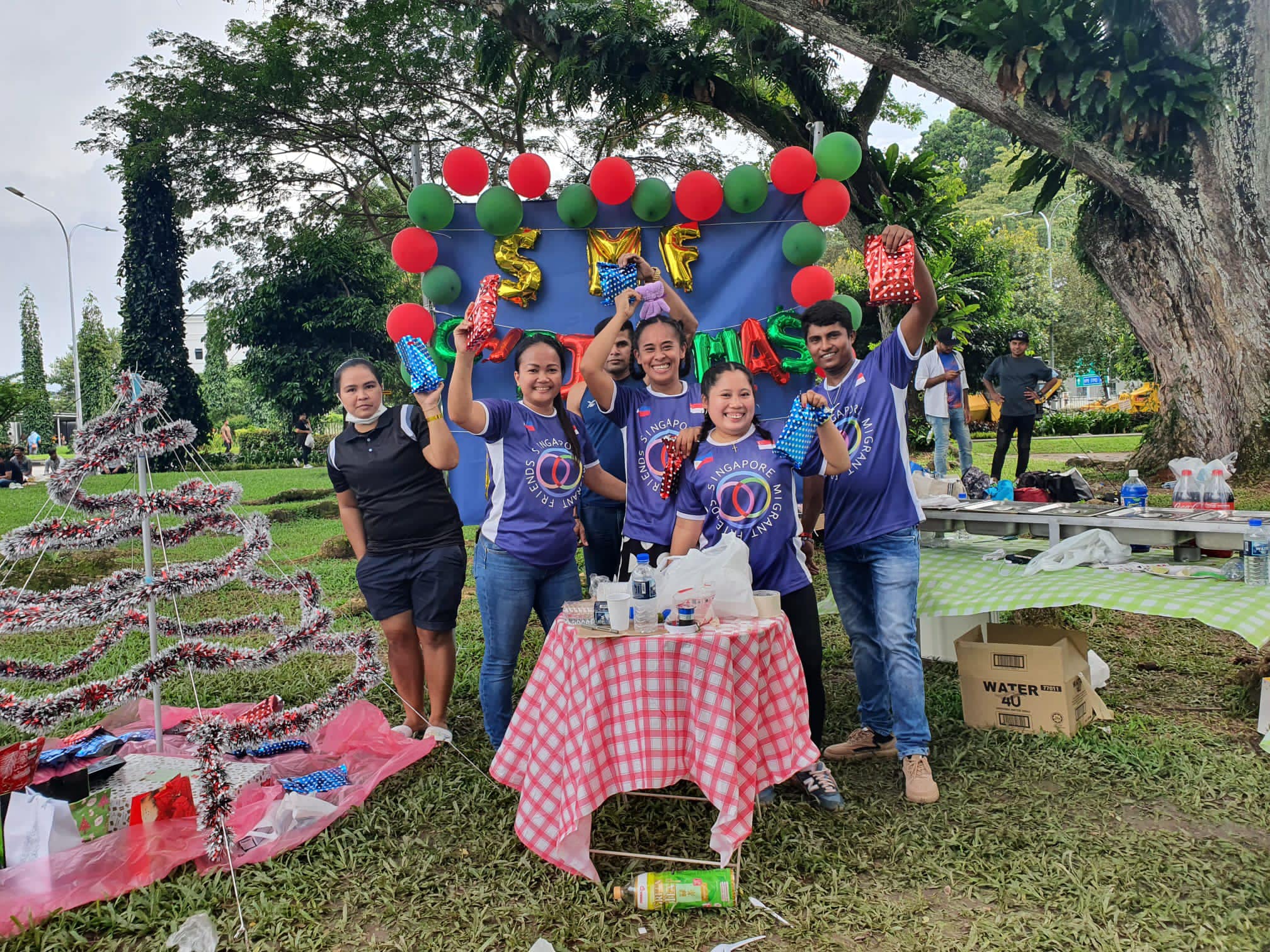 SMF members at a Christmas celebration event in 2022. Photo via SMF on Facebook.
SMF members at a Christmas celebration event in 2022. Photo via SMF on Facebook.
SMF has also served as a platform for workers to interact with local Singaporeans.
Pre-pandemic, SMF had friendly games with local student volleyball teams, and beyond the games, volunteers have also gotten involved in teaching the workers basic English, and photography.
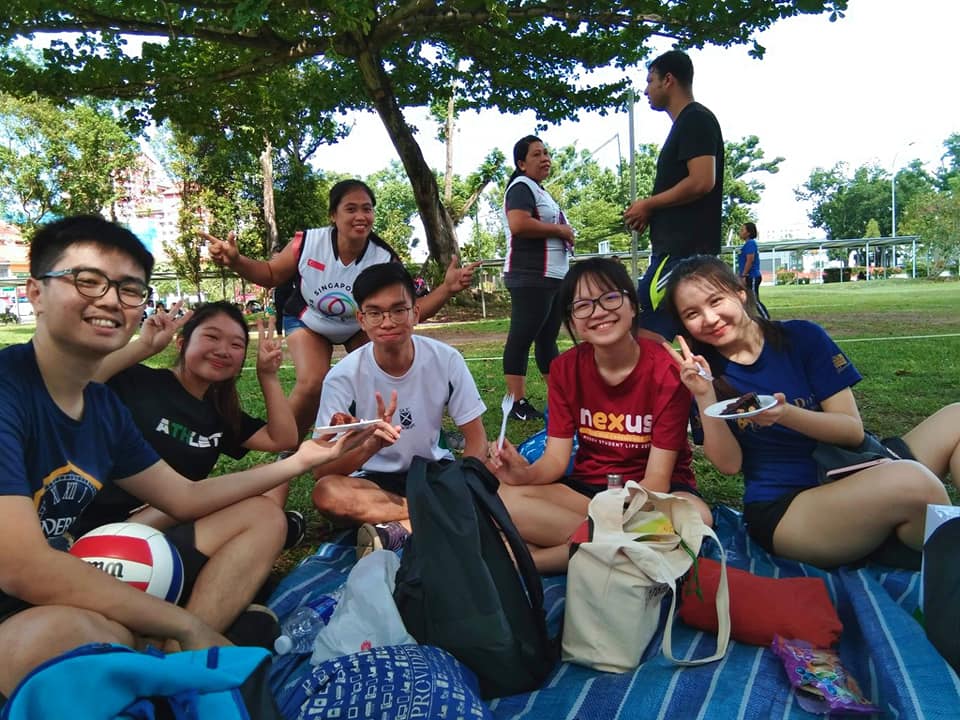 NUS students picnicking with SMF members at the Kallang field in December 2019.
NUS students picnicking with SMF members at the Kallang field in December 2019.
Mamun shared his hope that SMF could facilitate more of such interactions in future.
"I hope more local people who will come and teach us about local community, so we have more chance to know each other," he said.
Cai Yinzhou, founder of Citizen Adventures, said he first became acquainted with some of the group's original members in the early 2010s — through playing badminton with them in the back alleys of Geylang. He explained that SMF was a "spin-off" from those badminton games.
Cai recounted how Citizen Adventures' staff and volunteers got involved in "stimulating them to do more" — for example, organising visits to places other than the Kallang fields, or classes for the workers.
Cai also helped to organise a friendly match involving volleyballers from Geylang Methodist School (Secondary).
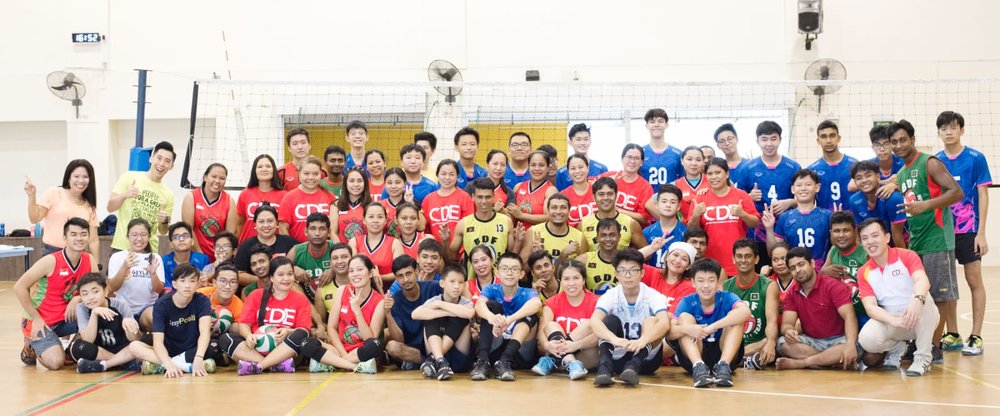 Group photo after a volleyball friendly match with Geylang Methodist School (Secondary) in April 2019. Photo via Citizen Adventures website.
Group photo after a volleyball friendly match with Geylang Methodist School (Secondary) in April 2019. Photo via Citizen Adventures website.
Going beyond just playing volleyball
Helping more workers find a healthy avenue for exercise and recreation are the obvious outcomes of these volleyball games, but there's more to it than just that.
Mamun described SMF as a "self-helping platform" for migrant workers in Singapore, saying:
"Migrants really don't have family and friends here... So if we have any problem there is really nobody to help."
“Many people don’t know their rights,” says Mamun.
He added the caveat that he’s grateful for all that has been done for migrant workers, but explained that "you cannot expect that everything goes smoothly" — there are sometimes unfortunate situations where workers need extra support — where they are cheated by errant agents, left unpaid by their employers, or sustain an injury at work, for example.
“We believe all migrants have same feelings," said Mamun, explaining that in SMF, "we spend our time together, we share our stress, our problems, and we stand for each other".
Cai explained that he occasionally gets roped in to help these workers get assistance, directing them to various community organisations that serve migrant workers in Singapore where required.
He highlighted an incident in the past where he, along with Mamun, made a police report for a migrant worker who had fallen prey to a job scam.
During Covid-19, Citizen Adventures also worked with SMF as part of the Covid-19 Migrant Support Coalition (CMSC), coordinating relief efforts targeted at workers in smaller dormitories where additional support was required.
CMSC also helped translate key government communications into workers' native languages, and SMF was "well-positioned" to be a source of information for migrants in those turbulent times, thanks to their existing networks, said Cai.
These days, support from Citizen Adventures mainly takes the form of providing funding and supporting the team's programmes — such as SMF's recent National Day celebration event.
"I think the intention is also not to manage them, but to allow them to be self-managed and have autonomy. So I think we've been able to achieve that," said Cai.
What happens when the field is redeveloped?
In urban Singapore, the only constant is change.
Remarkably, the field where the workers play has managed to remain largely untouched for nearly 80 years — since 1955, when Paya Lebar Airport opened and the Old Kallang Airport was decommissioned.
In fact, you can still find remnants of the airport at the field:
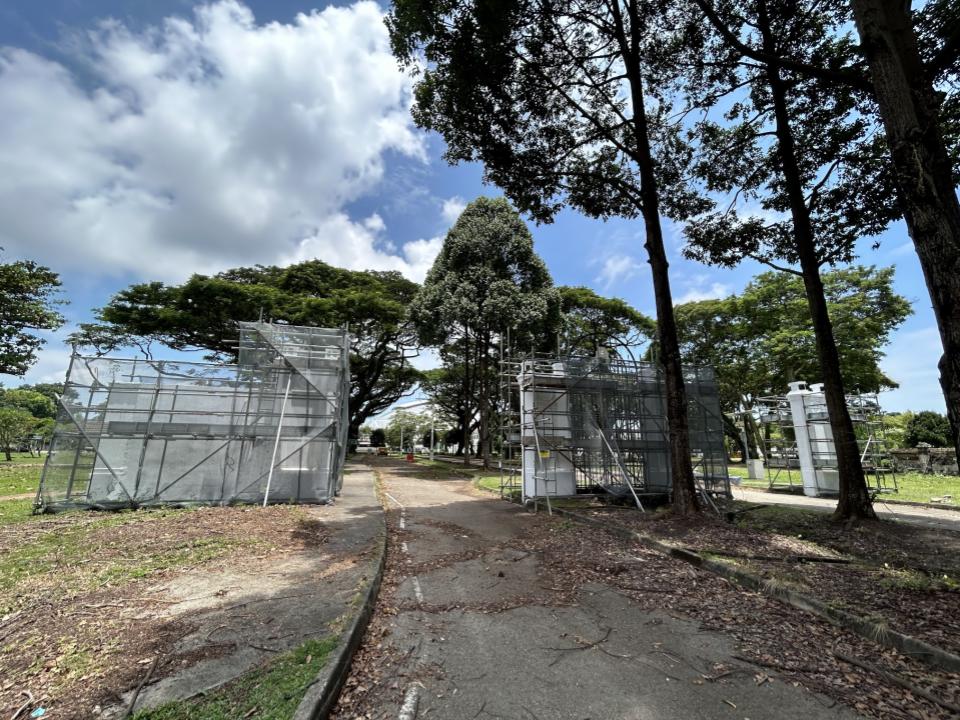 The Old Kallang Airport gateway, a conserved structure that is currently undergoing restoration work. Photo by Nigel Chua.
The Old Kallang Airport gateway, a conserved structure that is currently undergoing restoration work. Photo by Nigel Chua.
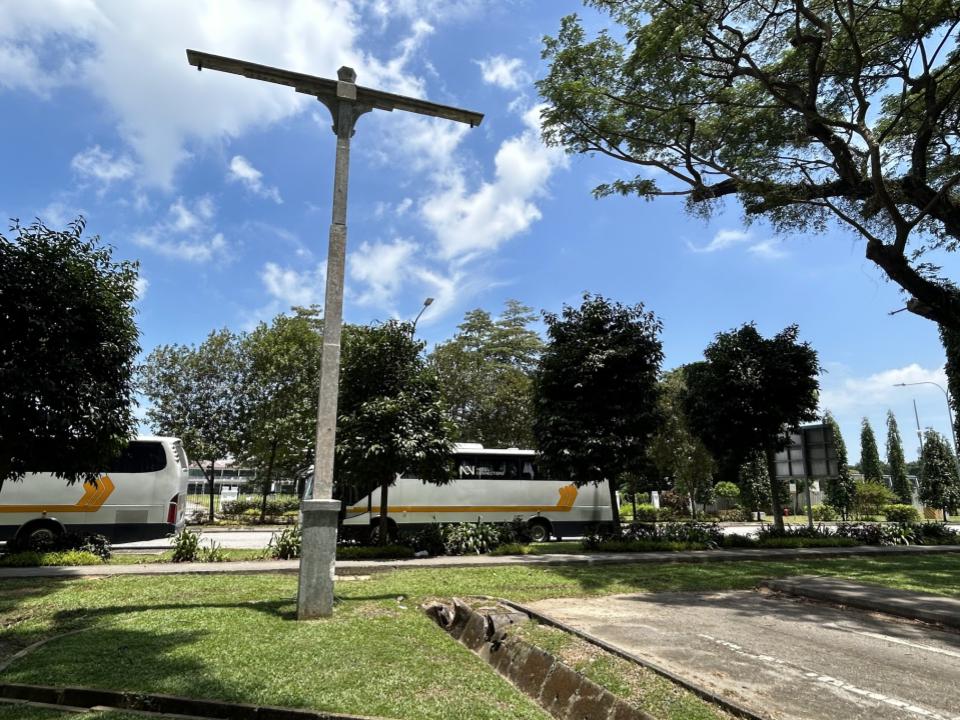 A colonial-era signpost towering over the road leading to the Old Kallang Airport. Photo by Nigel Chua.
A colonial-era signpost towering over the road leading to the Old Kallang Airport. Photo by Nigel Chua.
It's not been left vacant by accident or oversight — parts of the site were designated for conservation in 2008, given its significance as Singapore's first commercial international airport, built in the 1930s by the British colonial government.
However, the field won't be left vacant forever — it's one of the sites listed under the "Reinventing Spaces into Vibrant Places (RSVP)" programme by the Singapore Land Authority and URA.
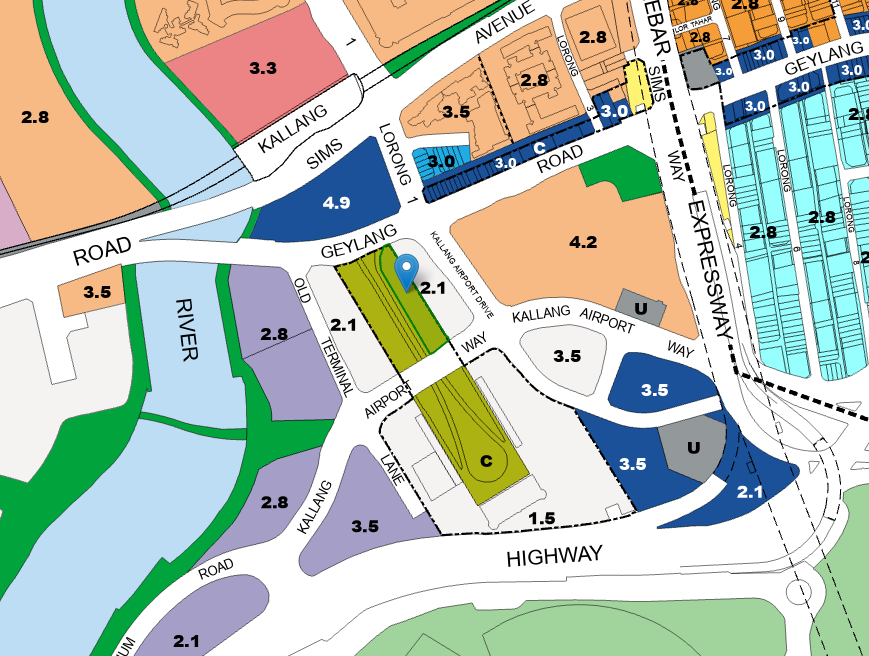 Screenshot from Urban Redevelopment Authority (URA) Master Plan.
Screenshot from Urban Redevelopment Authority (URA) Master Plan.
The stretch of disused road that once led to the Old Kallang Airport terminal building is coloured olive green on the URA Master Plan, meaning that it has been designated to remain as open space.
But on either side of that open space, where Singapore's migrant worker volleyball players have found a home, provision has been made for mixed-use developments up to 24 storeys high, given its Gross Plot Ratio of 2.1.
“We hope that the RSVP programme will help inject more vitality and delight into our precincts, turning vacant spaces into places that encourage people to venture, connect and interact,” said Chou Mei, URA's Group Director of Conservation & Urban Design.
In one sense, she's right. If you visited the Kallang field on a weekday, it is exactly that — a vacant space.
Yet, even as it is right now, it's already a place for people to venture, connect and interact.
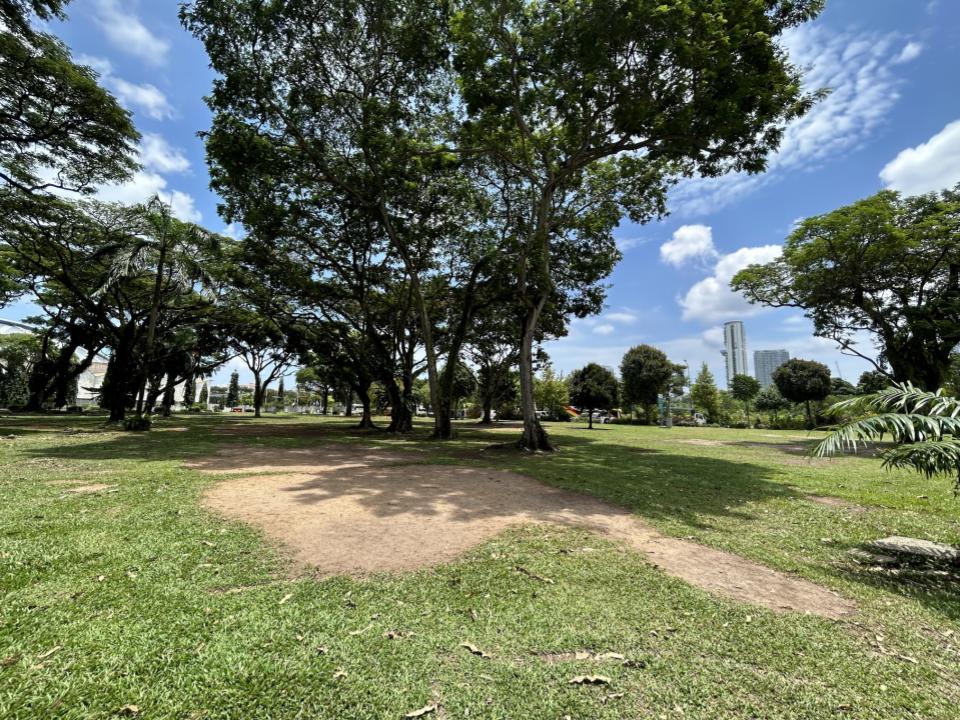
Top photo by Nigel Chua and via Singapore Migrant Friends on Facebook
Have something even more interesting going on in your neighbourhood? One-up us at [email protected].
Firsthand is a new content pillar by Mothership, featuring in-depth stories about people and their issues.
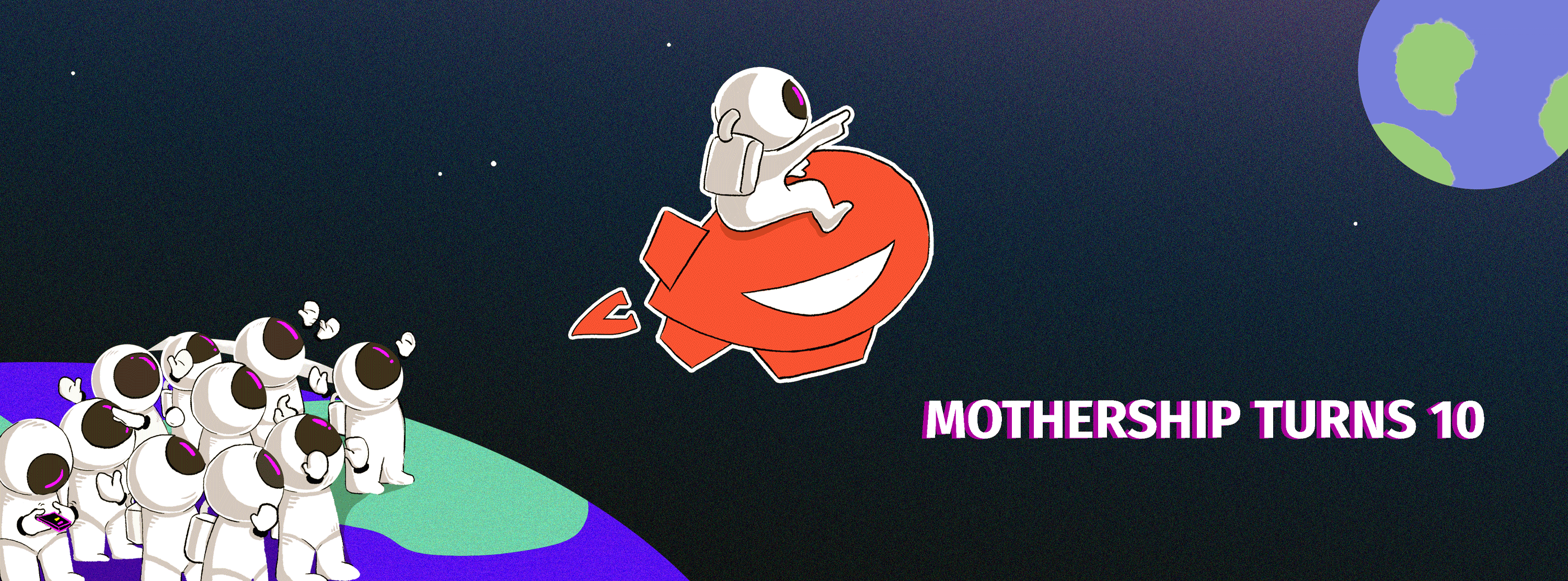
If you like what you read, follow us on Facebook, Instagram, Twitter and Telegram to get the latest updates.

